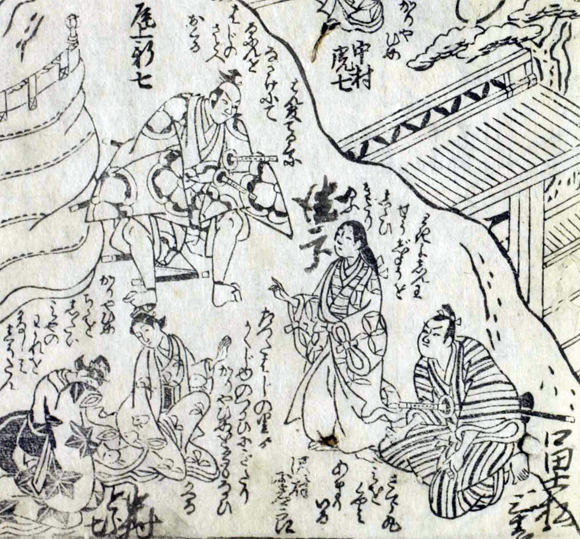| YASUI NO HAMA |
| Play titles | Sugawara Denju Tenarai Kagami |
| Common title | Yasui no Hama |
| Authors | Takeda Izumo I Miyoshi Sh˘raku Namiki Senryű I Takeda Koizumo I (Takeda Izumo II) |
| History |
The play "Sugawara Denju Tenarai Kagami" was originally written for the puppet theater (Bunraku) and staged for the first time in the 8th lunar month of 1746 in ďsaka at the Takemotoza. It was adapted for Kabuki the following month and staged for the first time in Ky˘to at the Kitagawa no Shibai, produced by Nakamura Kiyosabur˘ I [casting]. It was also performed for the first time in Edo, at the Ichimuraza, in the 3rd lunar month of 1747 [casting]. This great play is based on the life of Sugawara no Michizane (845~903), a renowned scholar who was promoted up to the prestigious rank of udaijin ("Right Minister", one of the 2 close advisors of the Emperor). Falsely accused by Fujiwara no Shihei, the "Left Minister" (sadaijin), of trying to hatch a plot with Prince Tokiyo to seize the power, Sugawara no Michizane was exiled to Kyűshű. He dedicated his last years in writing poems, expressing both his homesickness and his innocence. After his death, the Emperor's residence was often struck by lightning and people thought it was done by the vengeful spirit of Sugawara no Michizane. A shrine was built in Ky˘to to appease the spirit, the Kitano Tenmangű, and Sugawara no Michizane was revered as a the God of calligraphy. In the play Sugawara no Michizane is called Kan Sh˘j˘. "Yasui no Hama" ('The shore at Yasui') has not been staged since the end of WWII but it could be revived at the National Theatre in the future to come. |
| Structure |
"Sugawara Denju Tenarai Kagami" was made up of 5 acts. "Yasui no Hama" ('The shore at Yasui') is the second scene of the second act (naka). It fell into oblivion [1]. |
| Key words |
Daigo Tenn˘ Fujiwara Tokihira Gidayű Gidayű Ky˘gen Hangandai Heian Jidai Kago Kan Sh˘j˘ Naka ďch˘mono ďdaimono Settsu Sugawara Michizane Yasui |
| Summary |
Accompanied by Sakuramaru, Prince Tokiyo and Princess Kariya come to the port of Yasui where a ship carrying Kan Sh˘j˘ is at anchor. Sakuramaru appeals to the hangandai Terukuni, Kan Sh˘j˘'s escort, to allow Prince Tokiyo and Princess Kariya to meet Kan Sh˘j˘ but Terukuni refuses, saying that the couple are responsible for Kan Sh˘j˘'s misfortune. Sakuramaru thereupon suggests to Prince Tokiyo to part with Princess Kariya in order to appease the emperor's anger and thereby secure Kan Sh˘j˘'s pardon. Sakuramaru easily wins Prince Tokiyo's consent. Tatsuta-no-Mae, Kakuju's daughter and Princess Kariya's elder sister, arrives at the boat to ask Terukuni to permit Kan Sh˘j˘'s visit to the house of Kakuju before going to exile. Terukuni agrees and takes Kan Sh˘j˘ in a palanquin (kago) to bring him to Kakuju's residence. Meanwhile, Prince Tokiyo returns to the Imperial Palace, accompanied by Sakuramaru. |
| Notes |
[1] No record in ˘shibai between the end of WWII and 2024. |
 |
|
An illustration from an ezukushi banzuke depicting the "Yasui no Hama" scene of the drama "Sugawara Denju Tenarai Kagami", which was staged in the 9th lunar month of 1771 in Ky˘to at the Kitagawa Higashi no Shibai with Fujimatsu Sanjűr˘ I, Onoe Shinshichi I, Mimasu Tokujir˘ I, Sawamura Kunitar˘ I and Nakamura Torashichi in the roles of Sakuramaru, Terukuni, Prince Tokiyo, Tatsuta-no-Mae and Princess Kariya |
|
|
| Contact | Main | Top | Updates | Actors | Plays | Playwrights | Programs | Links | FAQ | Glossary | Chronology | Illustrations | Prints | Characters | Derivatives | Theaters | Coming soon | News |